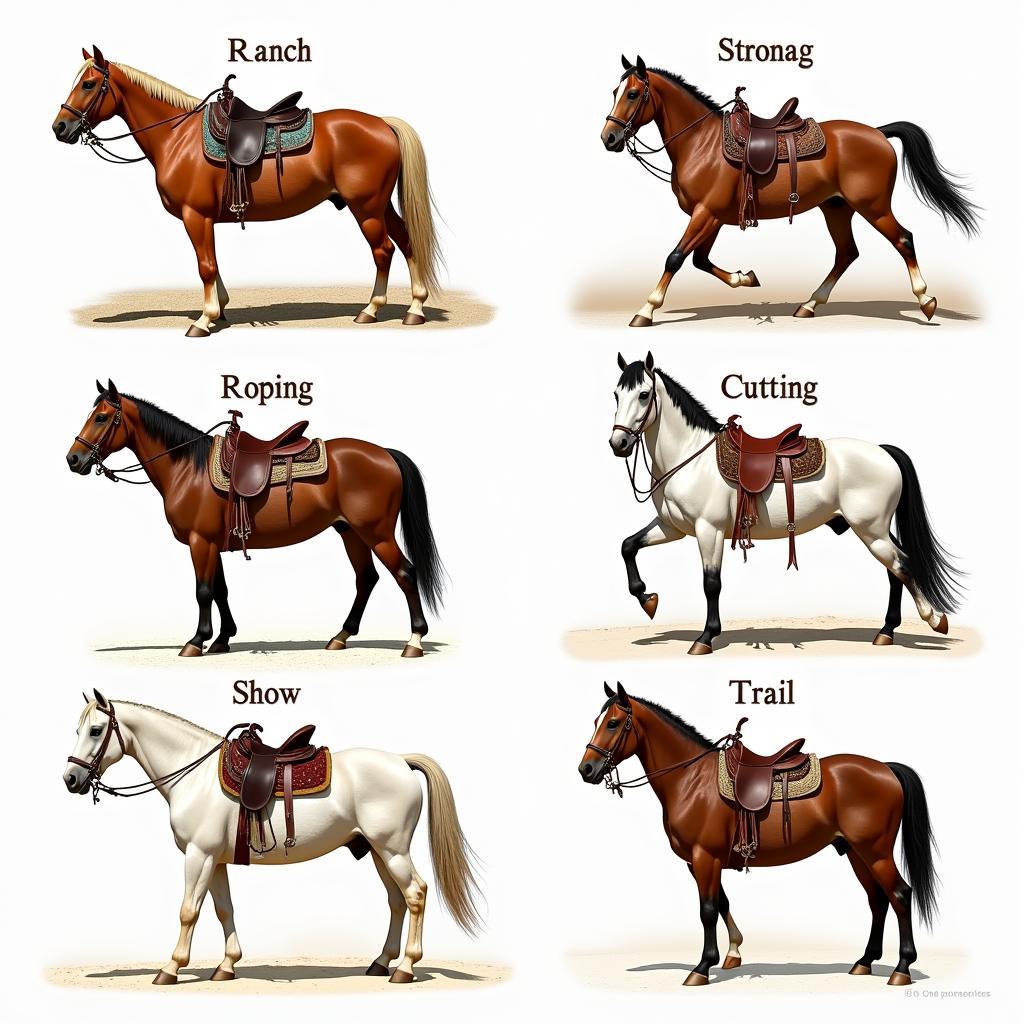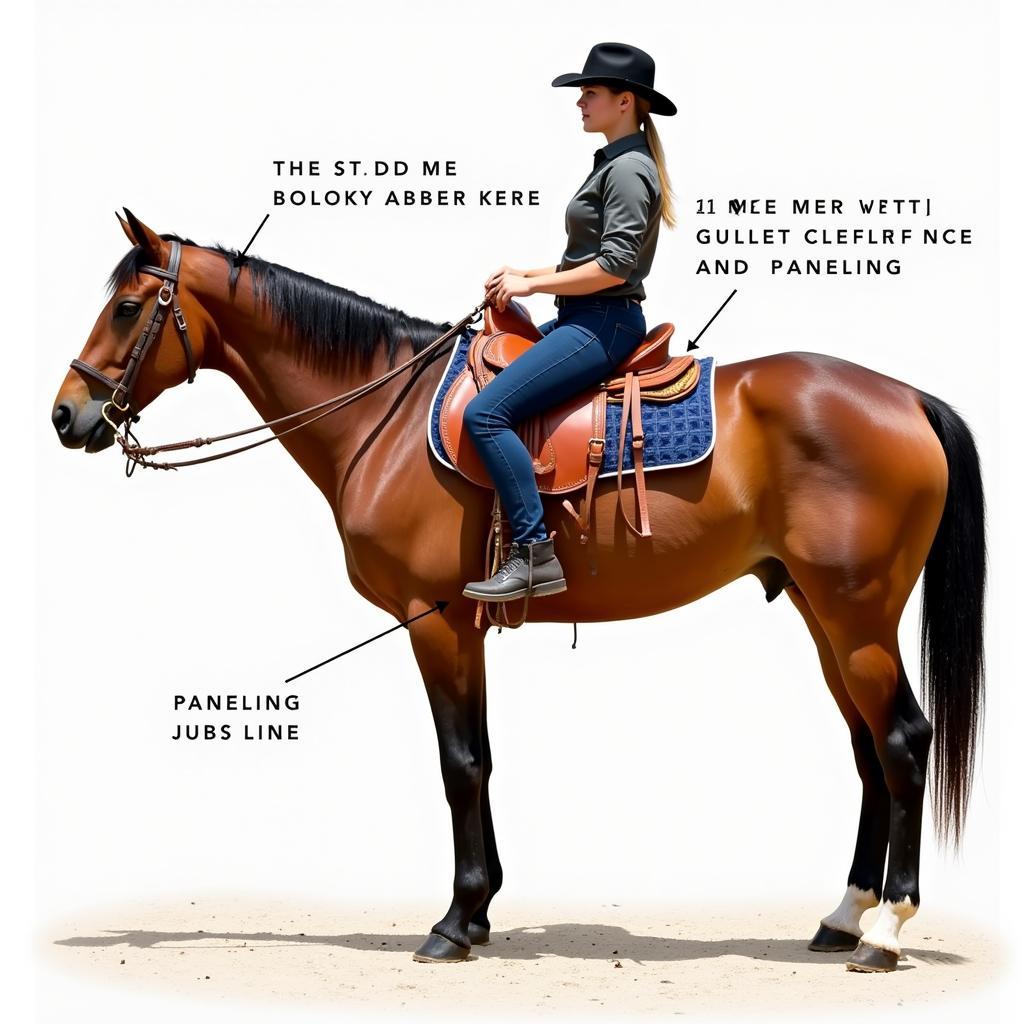A Quarter Horse Saddle is more than just a piece of equipment; it’s the crucial link between you and your horse. Choosing the right one ensures both your comfort and your horse’s performance. This guide will delve into everything you need to know about selecting the perfect quarter horse saddle, from understanding different types to fitting it correctly.
Understanding Quarter Horse Saddle Types
Quarter Horses are renowned for their stocky build and athleticism, requiring a saddle designed specifically for their conformation. Several types of quarter horse saddles cater to various riding disciplines. Understanding these distinctions is the first step in finding your perfect fit.
Common Quarter Horse Saddle Styles
- Ranch Saddles: Designed for the rigors of everyday ranch work, these saddles are built for durability and comfort, featuring a deep seat and high cantle for stability.
- Roping Saddles: Built for the demands of roping events, these saddles have a sturdy tree, a low horn for securing a rope, and a flatter seat for quick movements.
- Cutting Saddles: Tailored for the precision of cutting competitions, these saddles typically have a flatter seat, a higher cantle, and a prominent horn for balance.
- Show Saddles: Focusing on aesthetics, these saddles come in various styles, often adorned with silver accents, and are tailored for specific show events.
- Trail Saddles: Prioritizing comfort for long rides, these saddles feature a deep seat, padding for both horse and rider, and often include extra rings for attaching gear.
Finding the right saddle type depends entirely on your riding style and the activities you’ll be participating in. For example, a ranch saddle might be ideal for daily work, while a cutting saddle is essential for competitive cutting.
After this paragraph, insert the first shortcode image.
 Different Quarter Horse Saddle Types for Various Riding Disciplines
Different Quarter Horse Saddle Types for Various Riding Disciplines
Key Considerations When Choosing a Quarter Horse Saddle
Beyond the basic saddle types, several other factors contribute to a perfect fit. Consider these points before making a purchase.
Saddle Fit for Your Horse
- Tree Width: The tree is the internal frame of the saddle and must fit your horse’s back perfectly. An ill-fitting tree can cause discomfort and even injury. Quarter Horses typically require a wider tree compared to other breeds. A quarter horse bars on a saddle guide can offer further insights into the significance of proper bar placement.
- Gullet Clearance: Adequate gullet clearance ensures that the saddle doesn’t pinch the horse’s spine or wither. This is crucial for the horse’s comfort and freedom of movement.
- Paneling: The paneling under the saddle distributes pressure evenly across the horse’s back. Proper paneling is essential for preventing pressure points and sores.
Saddle Fit for the Rider
- Seat Size: The seat size should accommodate the rider comfortably. A seat that is too small or too large will affect balance and control.
- Stirrup Placement: Correct stirrup placement allows the rider to maintain a balanced and effective leg position.
- Saddle Material: Leather is the most common material, offering durability and a classic look. Synthetic materials are also available, providing a lightweight and often more affordable option.
Choosing the right quarter horse saddle is a critical decision. Investing time and effort in finding the perfect fit will enhance your riding experience and safeguard your horse’s well-being. You might also consider checking out upcoming horse shows in wisconsin to see different saddle styles in action.
After this paragraph, insert the second shortcode image.
 Properly Fitting a Quarter Horse Saddle for both Horse and Rider
Properly Fitting a Quarter Horse Saddle for both Horse and Rider
Where to Find Your Ideal Quarter Horse Saddle
You can find quarter horse saddles at various retailers, including tack shops, online stores, and even at some horse for sale jacksonville fl locations. For more options, consider browsing horses for sale sacramento. Remember, working with a reputable saddle fitter is highly recommended, especially if you’re unsure about proper fit. They can assess your horse’s conformation and your riding style to help you find the perfect saddle. Sometimes, you can even find a great horse t at these locations.
Expert Insights
“A well-fitting saddle is the foundation of a good riding experience,” says renowned equine veterinarian, Dr. Emily Carter. “Investing in a properly fitted saddle is an investment in your horse’s health and your own riding enjoyment.”
Equine trainer, John Davies, adds, “Don’t underestimate the importance of trying out different saddles before making a purchase. What works for one rider and horse may not work for another.”
After this paragraph, insert the third shortcode image.
Conclusion
Choosing the perfect quarter horse saddle requires careful consideration of both horse and rider needs. By understanding the different types of saddles, focusing on key fitting aspects, and seeking expert advice, you can ensure a comfortable and rewarding riding experience for you and your equine partner. Remember, the right quarter horse saddle is an investment in the long-term health and happiness of both horse and rider.
FAQ
- What is the average lifespan of a quarter horse saddle?
- How often should I clean my quarter horse saddle?
- Can I use a western saddle on a quarter horse?
- What are the signs of an ill-fitting saddle?
- How much does a good quality quarter horse saddle cost?
- What are the different tree types for quarter horse saddles?
- Where can I find a qualified saddle fitter?
Need more assistance? Contact us: Phone: 0772127271, Email: [email protected] Or visit us at: QGM2+WX2, Vị Trung, Vị Thuỷ, Hậu Giang, Việt Nam. We have a 24/7 customer support team.